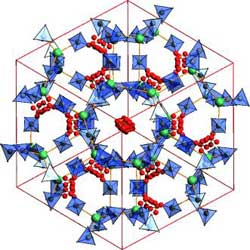Full to the Brim with Hydrogen

Hydrogen could be one of the most important fuels in a new energy economy based on renewable resources. However, no ideal hydrogen storage material has yet been found. A team led by Yaroslav Filinchuk at the Universit¨¦ Catholique de Louvain, Belgium, and Torben R. Jensen at the University of Aarhus in Denmark has now introduced a new highly porous form of magnesium borohydride in the journal Angewandte Chemie. This material can store hydrogen in two ways: chemically bound and physically adsorbed.
The perfect hydrogen storage material must store hydrogen efficiently and securely in a small volume, and should release it on demand. It must be rapidly refillable under mild conditions, while being as light and inexpensive as possible. One approach to this is solid-state storage. In such systems, hydrogen can be chemically bound, as in borohydride compounds, or it can be adsorbed as a molecule into a nanoporous material, as in some metal¨Corganic frameworks.
The researchers have now found a material that can do both. It is a new, highly porous form of magnesium borohydride¡ªthe first light-metal hydride that is porous like a metal¨Corganic framework and is capable of storing molecular hydrogen.
Magnesium borohydride (Mg(BH4)2) is one of the most promising materials for chemical hydrogen storage because it releases hydrogen at relatively low temperatures and can hold a high proportion by weight (about 15 %) of hydrogen. Two forms of this compound, ¦Á and ¦Â, were previously known. The researchers have now made a third form, designated the ¦Ã form. Its pore volume comprises about 33 % of the structure, and its channels are wide enough to take up and store small gas molecules, such as nitrogen, dichloromethane, and most importantly hydrogen.
Interestingly, under high pressure this material converts into a nested, non-porous framework with a density that is nearly 80 % higher. This makes the ¦Ä form the second densest in hydrogen content and more than twice as dense as liquid hydrogen. Furthermore, this conversion results in a 44 % reduction in volume, which is the largest contraction yet observed for a hydride.
¡°A combination of the chemical (through covalent bonding) and physical (through adsorption in the pores) storage of hydrogen seems to be difficult in practical applications,¡± explains Filinchuk. ¡°However, this research has a broader impact, as it reveals a new class of hydride-based porous solids for storage and separation of various gases.¡±
Author: Yaroslav Filinchuk, Universit¨¦ Catholique de Louvain, Louvain-la-Neuve (Belgium), http://filinchuk.com/
Title: Porous and Dense Magnesium Borohydride Frameworks: Synthesis, Stability, and Reversible Absorption of Guest Species
Angewandte Chemie International Edition, Permalink to the article: http://dx.doi.org/10.1002/anie.201100675
Media Contact
All latest news from the category: Life Sciences and Chemistry
Articles and reports from the Life Sciences and chemistry area deal with applied and basic research into modern biology, chemistry and human medicine.
Valuable information can be found on a range of life sciences fields including bacteriology, biochemistry, bionics, bioinformatics, biophysics, biotechnology, genetics, geobotany, human biology, marine biology, microbiology, molecular biology, cellular biology, zoology, bioinorganic chemistry, microchemistry and environmental chemistry.
Newest articles

Properties of new materials for microchips
… can now be measured well. Reseachers of Delft University of Technology demonstrated measuring performance properties of ultrathin silicon membranes. Making ever smaller and more powerful chips requires new ultrathin…

Floating solar’s potential
… to support sustainable development by addressing climate, water, and energy goals holistically. A new study published this week in Nature Energy raises the potential for floating solar photovoltaics (FPV)…

Skyrmions move at record speeds
… a step towards the computing of the future. An international research team led by scientists from the CNRS1 has discovered that the magnetic nanobubbles2 known as skyrmions can be…





















